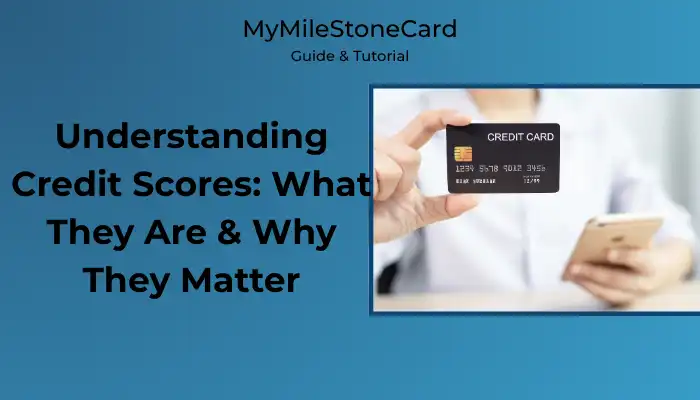Discover how your MyMilestoneCard credit score can shape your financial future! In this guide, we’ll explore the Milestone Card role in credit, tips for responsible credit card use, and how to start monitoring credit effectively.

Whether you’re applying for Milestone Card or already using the MyMilestoneCard login or MyMilestoneCard app, we’ll help you make informed financial decisions.
From a credit building summary to sustaining good credit, this is your roadmap to a path to better credit and long-term credit score growth. Let’s get started!

MyMilestoneCard Credit Score: How This Card Impacts Your Credit
Let’s dive into the nitty-gritty of how the Milestone Credit Card can shape your MyMilestoneCard Credit Score, for better or worse. I’ll walk you through the positive impacts, the negative impacts, and some pro tips to make this card work for you like a charm.
As someone who’s navigated the credit-building maze myself (and made a few rookie mistakes), I’m excited to share what I’ve learned to help you boost your financial health.
Positive Impacts of the MyMilestoneCard credit score
The Milestone Card positive impact is real, especially if you’re starting with a blank slate or a bruised credit history.
Here’s how it can be your ally in building credit with Milestone:
- Helps Build Credit History
- Ideal for individuals with limited or poor credit
- Provides access to unsecured credit for establishing a credit track record
- Reports to Major Credit Bureaus
- Monthly reporting to Equifax, Experian, and TransUnion
- On-time payments contribute to a stronger credit profile
- Improves Credit Utilization Ratio balance before the statement closes can make your utilization look even better.
Here’s a quick look at how these factors play into your MyMilestoneCard Credit Score:
| Factor | How Milestone Helps |
|---|---|
| Building credit history | Establishes a track record for those with little to no credit. |
| Credit bureau reporting | Reports payments to Equifax, Experian, TransUnion, boosting your score with good behavior. |
| Improving credit utilization | Low My Milestone Card balance relative to your limit improve your credit utilization ratio. |
Used wisely, the Milestone Card can jumpstart your credit journey. But before you swipe away, let’s talk about the flip side.
Negative Impacts of MyMilestoneCard credit score
Now, let’s talk about the Milestone Card negative impact. I’m not going to sugarcoat it—this card can bite if you’re not careful.
Here’s where things can go wrong:
- High Fees and Interest Rates
- Annual and/or monthly maintenance fees
- High APRs lead to costly balances over time
- Paying only the minimum increases long-term debt
- Low Credit Limit
- Initial credit limit often around $300
- Difficult to maintain a healthy credit utilization ratio
- High usage can negatively impact your MyMilestoneCard Credit Score
- Consequences of Missed Payments
- Late fees add to the balance
- Negative effect on payment history (35% of FICO score)
- Potential credit score drop from missed due dates
Here’s a table summarizing the pitfalls:
| Issue | Potential Impact on Credit Score |
|---|---|
| High fees credit card | Can lead to debt, increasing credit utilization and stress on finances. |
| Low credit limit challenges | High utilization if you’re not careful, hurting your score. |
| Missed payment consequences | Damages payment history and may add fees, lowering your score. |
Those fees and limits can hurt if you’re not cautious. Let’s explore how to use the card smartly and dodge the pitfalls.
Tips to Maximize MyMilestoneCard Credit Score Benefits
Alright, you’re ready to make the MyMilestoneCard credit score your credit-building sidekick.
Here’s the tips and why it matters for maximizing credit benefits:
| Tip | Why It Matters |
|---|---|
| Pay on time, every time | Builds a strong payment history—set up autopay or reminders to stay on track. |
| Keep utilization low | Using less than 30% of your credit limit shows responsible credit usage. |
| Pay off balances monthly | Helps avoid high interest charges and keeps debt from piling up. |
| Monitor your credit | Spot errors early—check reports regularly at AnnualCreditReport.com. |
| Know when to upgrade | Better cards offer lower fees and higher limits once your score improves. |
By following these tips, you’re not just using the card—you’re leveraging this platform to build a solid MyMilestoneCard credit score. It’s like turning a clunky old car into a sleek credit-building machine!
In short, the MyMilestoneCard credit score can be a powerful tool for building credit with Milestone, but only if you play it smart. Use it to establish a history, keep an eye on credit bureau reporting, and avoid the traps of high fees and low credit limit challenges.
I’ve been there, and with a bit of discipline, you can make this card work wonders for your MyMilestoneCard credit score. Stay sharp, and let’s keep your credit journey on the right track!

Understanding Credit Scores: What They Are & Why They Matter
Before you can really take control of your financial future, you need to understand your credit score—what it is, why it matters, and how it can make or break your money moves.
Think of this as your credit crash course, minus the boring lectures. I’ll walk you through everything you need to know, from how scores are calculated to the models used behind the scenes.
Trust me, once you understand how credit scores work, using tools like the Milestone Credit Card becomes way more effective—and way less risky.
What Is a Credit Score?
In plain English, your credit score is a three-digit number that tells lenders how trustworthy you are with borrowed money. It’s like a financial reputation score—and just like a personal reputation, it’s easy to damage and harder to fix.
Lenders, landlords, insurance companies, even some employers look at it. That’s why the credit score importance can’t be ignored—it affects almost every major financial decision in your life.
Here’s a quick breakdown of score ranges and what they mean:
| Credit Score Range | Category | What It Means |
|---|---|---|
| 800 – 850 | Excellent | You’re golden. Access to the best rates. |
| 740 – 799 | Very Good | Lenders are happy. Good approval odds. |
| 670 – 739 | Good | Decent standing. Average terms. |
| 580 – 669 | Fair | Caution zone. Higher rates and fewer options. |
| Below 580 | Poor | High risk. Time to start rebuilding. |
When I started out, my score was in the “fair” zone—not awful, but not getting me anywhere exciting either. That’s when I learned that understanding your credit is just as important as having a credit card in the first place.
FICO vs. VantageScore
If you’ve ever checked your credit report and seen different numbers, you’re not crazy. There are two main scoring models: FICO and VantageScore. Both are legit, but they can give slightly different results.
Let me break them down:
| Scoring Model | Used By | Score Range | Key Difference |
|---|---|---|---|
| FICO Score | Most major lenders | 300–850 | Industry standard. Trusted by 90% of top lenders. |
| VantageScore | Some lenders & platforms | 300–850 | More forgiving for short credit histories. |
FICO is the old-school heavyweight; VantageScore is the modern up-and-comer. Most financial institutions use FICO, but many free platforms (like Credit Karma) show your VantageScore.
Knowing the difference is part of understanding your credit—because not all scores are created equal.
What Factors Affect Your Credit Score?
This is where things get real. Your credit score isn’t random. It’s calculated based on five key areas, and knowing them puts you in control.
1. Payment History Impact
This is the big one. Your record of MyMilestoneCard payment or any card payment on-time—or lack of—makes up over a third of your score. One late payment can haunt you for up to seven years.
I once missed a $14 payment (yep, fourteen bucks), and my score nosedived by 40 points. 1000% WRONG move.
Tips:
- Always pay at least the minimum.
- Set up automatic payments if you’re forgetful (like me).
Even a single missed payment can drag your score down for years—so protect it like your financial reputation depends on it (because it does).
2. Credit Utilization Ratio
This is the percentage of your available credit that you’re using. If your limit is $500 and your balance is $250, your utilization is 50%. That’s too high.
| Credit Limit | Balance | Utilization % | Impact |
|---|---|---|---|
| $500 | $400 | 80% | Hurting your score |
| $500 | $100 | 20% | Helping your score |
Keeping credit utilization low (under 30%, ideally under 10%) is one of the fastest ways to give your score a boost.
3. Credit History Length
This one’s all about how long you’ve had credit accounts open. The longer, the better. Lenders like seeing a solid track record.
Pro tip: Don’t close your oldest credit card, even if you don’t use it. I kept my first card open just for this reason—and it’s helped my credit history length stay strong.
The age of your oldest account can quietly carry your score—so think twice before closing long-standing cards.
4. Types of Credit
Mix it up. Having a credit card, a car loan, and maybe a student loan shows you can handle different types of debt responsibly.
Diversity in credit types = less risk in the eyes of lenders.
A healthy mix of credit types proves you can juggle multiple responsibilities—and lenders love that.
5. New Credit Inquiries
Every time you apply for a new line of credit, a hard inquiry hits your report. Too many hard inquiries too fast? That raises red flags.
How to manage this:
- Space out your applications.
- Only apply when necessary.
I learned this the hard way during my “apply-for-every-credit-card-you-can” phase. Not my proudest moment.
Credit Score Ranges
Let’s revisit the ranges quickly:
| Score Range | Meaning |
|---|---|
| 800 – 850 | Excellent |
| 740 – 799 | Very Good |
| 670 – 739 | Good |
| 580 – 669 | Fair |
| Below 580 | Poor |
Understanding where you fall—and why—is key to figuring out how to improve. If you’re aiming for a good MyMilestoneCard credit score, it’s not just about paying bills; it’s about playing the game wisely.
You’ve just learned what a credit score is, how it’s calculated, and which models lenders use to judge you. This isn’t just textbook knowledge—it’s practical, powerful stuff you can use to improve your financial life.
Armed with this foundation, you’ll be able to use tools like the Milestone Credit Card with confidence. Coming up next, I’ll break down exactly how that card impacts your score—for better or worse—and how to make it work for you, not against you.
Stick with me, you’re just getting started on mastering your credit journey.

Tracking Your MyMilestoneCard Credit Score
Keeping an eye on your credit score is one of the smartest moves you can make when using your MyMilestoneCard. Think of it like checking the scoreboard during a game—you want to know where you stand and how your moves are affecting your overall performance.
So, how exactly can you track your credit score when you have a MyMilestoneCard? Let me walk you through it.
MyMilestoneCard Credit Score Access
Here’s the honest truth: MyMilestoneCard credit score access is not directly built into the card’s official website or app. That means you won’t find a nifty dashboard showing your score every time you log in.
I know, that’s a bit of a bummer, especially when you want everything in one place. But don’t worry, this doesn’t mean you’re flying blind.
Monitor Your MyMilestoneCard Credit score with Free Tools
Since MyMilestoneCard doesn’t provide direct access to your MyMilestoneCard credit score, your best bet is to use free credit score tools. These tools pull data from major credit bureaus and give you a pretty good idea of where you stand.
Here are my go-to recommendations:
- Credit Karma
This site/app is a lifesaver. It offers free, updated credit scores from TransUnion and Equifax, along with personalized tips. Bonus: it’s user-friendly and you can check as often as you like without worrying about hurting your score. - Experian Credit Score
Experian, one of the big three credit bureaus, offers free access to your Experian score. You can also sign up for alerts, which helps catch any sneaky changes on your report.
Both platforms are legit, free, and super easy to use. Plus, they can alert you to any suspicious activity or mistakes—which, spoiler alert, can tank your score if you let them slide.
Regularly Monitor Your MyMilestoneCard Credit Score
Here’s where a lot of people drop the ball: not regularly checking their credit. I get it; life gets busy, and ignoring your credit reports sounds easier than it is. But trust me, tracking credit progress is crucial.
Why? Because credit report changes don’t always play nice. Sometimes, errors sneak in (think: wrong payment marked late or a mysteriously high balance). Without regular checks, you could be losing points without knowing it.
That’s why identifying credit errors quickly can save you a world of headaches and keep your credit journey on track.
Proactive Credit Management
You might be wondering, “Okay, I can check my score, but what else?” The real power lies in proactive credit management.
Monitoring your credit regularly helps you:
- Spot credit score fluctuations before they spiral out of control.
- Understand how your MyMilestoneCard activity—like timely payments or utilization—affects your score.
- Catch fraudulent activity early and dispute errors ASAP.
I’ve had clients who ignored their credit reports for years, then got slammed by unexpected negative marks. That’s 1000% WRONG if you want to build credit smartly. The cool part? Staying on top of your credit report means you’re always in control.
Quick Tips to Use This to Your Advantage
To make the most of your credit-building journey with MyMilestoneCard credit score, it’s essential to stay proactive and organized.
These quick tips will help you track your credit effectively and avoid common pitfalls along the way.
| Tip | Why It Matters |
|---|---|
| Check your MyMilestoneCard credit score monthly | Keep tabs on your progress and errors. |
| Use multiple tools (Credit Karma & Experian) | Cross-reference for accuracy. |
| Set up alerts | Get notified immediately of changes. |
| Review your MyMilestoneCard statements | Verify payments and balances are correct. |
While MyMilestoneCard doesn’t give you MyMilestoneCard credit score access directly, there are plenty of free credit score tools to keep you in the loop.
By tracking your credit progress regularly, you’ll be way ahead of the game in understanding credit score fluctuations and preventing surprises. Think of it as your personal credit health check-up—easy, quick, and absolutely worth it.
So, ready to start monitoring your MyMilestoneCard credit score like a pro? Let’s get that credit journey moving in the right direction!
Milestone Credit Score FAQs
Here are some quick answers to common questions about how the Milestone Credit Card can impact and help build your MyMilestoneCard credit score
How does the Milestone Credit Card help build my credit score?
The Milestone Credit Card helps build your credit score by reporting your payment history monthly to major credit bureaus like Equifax, Experian, and TransUnion. It’s especially useful for those with limited or poor credit as it establishes a positive credit history when payments are made on time and balances are kept low.
What are the negative impacts of using the Milestone Credit Card on my credit score?
The Milestone Credit Card can negatively impact your credit if you’re not careful. High fees, low credit limits, and missed payments can lead to increased debt and damage your payment history, which lowers your credit score. Managing balances and paying on time is crucial to avoid these pitfalls.
How can I maximize the credit score benefits of my Milestone Credit Card?
To maximize your Milestone Credit Card benefits, always pay on time, keep your credit utilization below 30%, and pay off your balances monthly. Also, monitor your credit reports regularly and consider upgrading to better cards as your score improves to maintain a strong credit profile.
What credit score ranges should I know about?
Credit scores generally range from 300 to 850. Scores between 800-850 are excellent, 740-799 very good, 670-739 good, 580-669 fair, and below 580 poor. Knowing where you stand helps you understand your financial options and what steps to take to improve your credit health.
Does the MyMilestoneCard provide direct access to my credit score?
No, the MyMilestoneCard website and app do not offer direct credit score access. However, you can track your credit score using free services like Credit Karma and Experian, which pull data from major credit bureaus and provide useful alerts.
Understanding these basics will help you use your Milestone Credit Card wisely and improve your MyMilestoneCard credit score over time.
Conclusion
Ready to unlock your credit potential? MyMilestoneCard credit score success starts with understanding the Milestone Card role in credit and practicing responsible credit card use.
By monitoring credit effectively and using financial education resources, you can make informed financial decisions—whether you’re applying for Milestone Card or maximizing its benefits.
This credit building summary sets you on the path to better credit, helping with sustaining good credit habits for long-term credit score growth. Your stronger financial future begins today!
